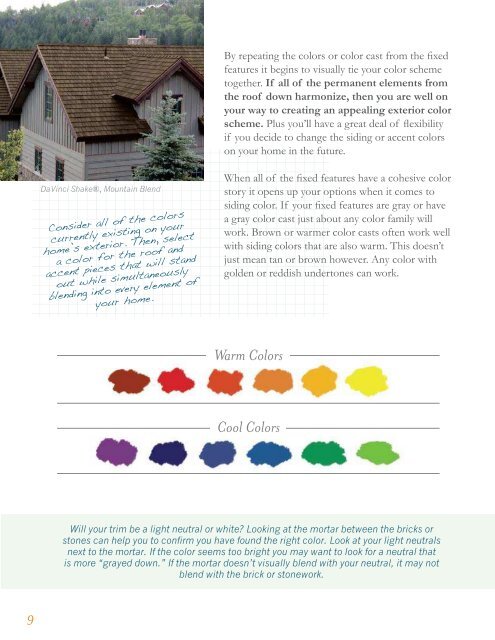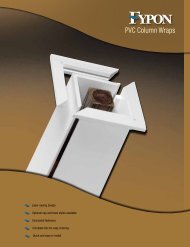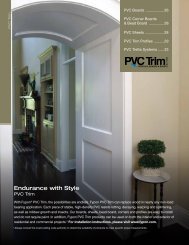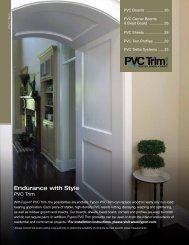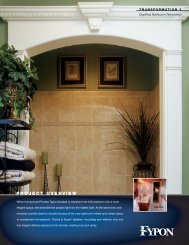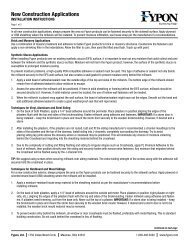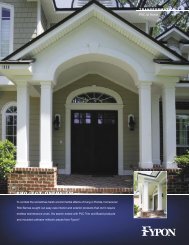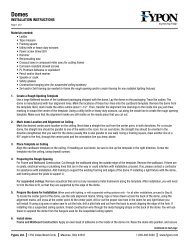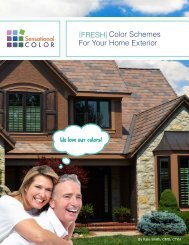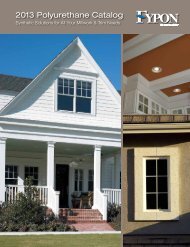Create successful ePaper yourself
Turn your PDF publications into a flip-book with our unique Google optimized e-Paper software.
DaVinci Shake®, Mountain Blend<br />
Consider all of the colors<br />
currently existing on your<br />
home’s exterior. Then, select<br />
a color for the roof and<br />
accent pieces that will stand<br />
out while simultaneously<br />
blending into every element of<br />
your home.<br />
By repeating the colors or color cast from the fixed<br />
features it begins to visually tie your color scheme<br />
together. If all of the permanent elements from<br />
the roof down harmonize, then you are well on<br />
your way to creating an appealing exterior color<br />
scheme. Plus you’ll have a great deal of flexibility<br />
if you decide to change the siding or accent colors<br />
on your home in the future.<br />
When all of the fixed features have a cohesive color<br />
story it opens up your options when it comes to<br />
siding color. If your fixed features are gray or have<br />
a gray color cast just about any color family will<br />
work. Brown or warmer color casts often work well<br />
with siding colors that are also warm. This doesn’t<br />
just mean tan or brown however. Any color with<br />
golden or reddish undertones can work.<br />
Warm Colors<br />
LOOK<br />
regional colors<br />
at your geography to influence the<br />
color scheme of your home’s exterior. For<br />
example, a brighter terra cotta color that would<br />
seem garish in northern climates may be an<br />
excellent choice for areas where the sunlight is<br />
intense.<br />
East Coast Midwest South Regional color<br />
preferences come from a blend of the region’s<br />
natural characteristics -- climate, topography,<br />
landscape and quality of the natural light --<br />
together with the housing styles, available<br />
materials and cultural history of the area.<br />
In the Northwest, natural gold-based and green hues that reflect the colors found in the<br />
natural environment are popular. Nature also influences home colors in the mountain states<br />
where the colors of stone, rock and natural woods are incorporated into the color schemes.<br />
The Southwest trends towards neutral sandy or sun-drenched terra cotta colors accented<br />
with coral, turquoise, brown and green. These colors are still rooted in nature but they use<br />
more vibrant hues that will not pale in the bright sunlight.<br />
Cool Colors<br />
Will your trim be a light neutral or white Looking at the mortar between the bricks or<br />
stones can help you to confirm you have found the right color. Look at your light neutrals<br />
next to the mortar. If the color seems too bright you may want to look for a neutral that<br />
is more “grayed down.” If the mortar doesn’t visually blend with your neutral, it may not<br />
blend with the brick or stonework.<br />
Across the country, homes in the Northeast tend to<br />
be clad in traditional colors with deeper or brighter<br />
accents. White with black shutters, gray with a red<br />
front door, or natural stain with green trim are<br />
examples of the schemes you might find in the New<br />
England region. In the Midwest, white, tan and gray<br />
are popular color choices. These same colors are<br />
found in the Southeast, with more emphasis on tans,<br />
greens, blues, and grays in coastal areas.<br />
{<br />
Suburban, urban or rural Wooded, desert,<br />
waterfront Balance the colors with your setting.<br />
{<br />
9<br />
10


